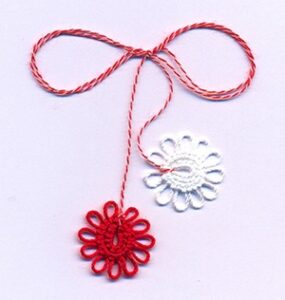Since Mărțișor is only a few days away, I am reminded that every year I struggle to explain this beautiful tradition to my American friends. I think that for those living in and around the Washington, DC area this may be even more of an issue as the event has been celebrated by the community for some 20 years and many of our American friends have even attended these events, may have seen pictures on social media, or saw a Romanian lady wear one.
So, to help with that, here is a simple, one pager explanation of what Mărțișor is and also trying to put it a bit into the regional context of the Balkans. Feel free to share this with your American friends.
Mărțișor (pronounced mərt͡siˈʃor / mar-tze-shore) is an ancient tradition celebrated on March 1st in Romania and the Republic of Moldova. A similar custom is found in Bulgaria and North Macedonia but also in Northern Greece and Southern Albania, areas with significant Aromanian communities. Also known as marț, marțu or mărțiguș, the names are a diminutive for the name of the month of March.

Mărțișor (and its variations from elsewhere in the Balkans) is defined by the red and white strings with hanging tassels which in Romania and the Republic of Moldova is often worn with a small talisman (or coin) believed to protect the wearer and bring about an affluent and healthy year. It is also perceived as a symbol of the coming spring. In the countryside, people hang a red and white string at their gates, windows, and also adorn the cattle’s horn and sheds to protect against evil spirits and to invoke nature’s regenerative powers. Nowadays, and especially in urban areas, the Mărțișor has lost most of its talisman powers and has become more of a symbol of friendship, love, appreciation and respect.

In Southern Romania and in Transylvania only women receive and wear a Marțișor. In Moldova and elsewhere, both women and men receive and wear the red and white strings. Traditionally, after wearing the Mărțișor for anywhere between eight days and a month, the strings are tied to a flowering tree to bring about a prosperous year while in other parts of Romania the small coins are used to buy fresh cheese used to treat the skin of the wearer so that it will be healthy and beautiful the entire year.
The origins of Mărțișor are lost in the mists of history. According to some historians it is a continuation of the Roman New Year which in antiquity was celebrated on the 1st of March. The month of March (‘Martius’) was named in the honor of the god Mars which was not only the god of war but was also the god of agriculture who ensured nature’s rebirth. Thus, Mărțișor is both the beginning of Spring but also its red and white colors can be explained as the colors of war and peace. Other historians believe this to be a more ancient custom that pre-dates even the Roman conquest of the Balkans. They point to the association of Mărțișor with ancient myths and especially with the story of Baba Dochia an old woman that in the folk tales of Romania and Moldova is the embodiment of a symbolic death and birth. In some versions it was in fact Dochia who spun the red and white threads associated with Mărțișor with the white symbolizing rebirth, purity and light, while red (black in some regions) symbolizing dead, blood, fecundation and fertility.


